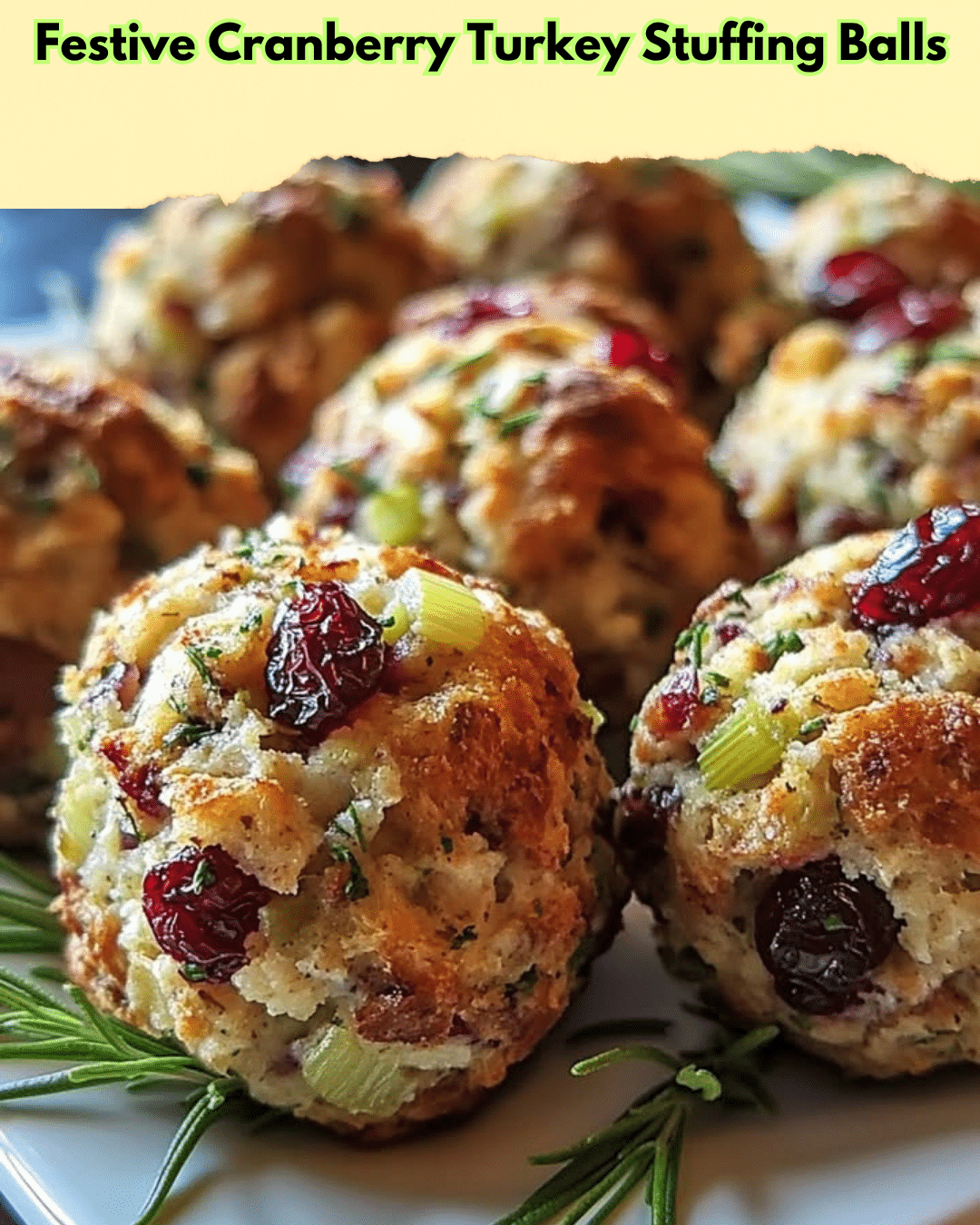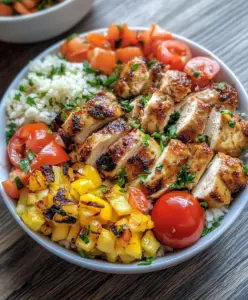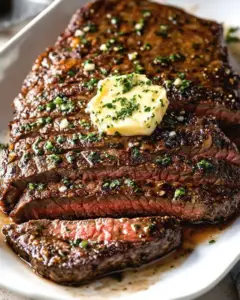Festive Cranberry Turkey Stuffing Balls: A Holiday Favorite
For the perfect holiday side dish, these Festive Cranberry Turkey Stuffing Balls are a definite crowd-pleaser. Imagine the delightful aroma of sage and thyme mingling with the rich, savory scent of turkey wafting through your kitchen. Combine that with a sweet cranberry surprise at the heart of each ball, and you have a culinary masterpiece that’s both delicious and visually stunning.
As you bite into these stuffing balls, the combination of textures will delight you. The outer layer is crisp and golden, giving way to a soft and tender interior filled with herb-seasoned stuffing and tart cranberries. Whether you’re serving them for a festive occasion or just a cozy family dinner, these stuffing balls add a touch of elegance and warmth to any table.
Quick Recipe Highlights
- Flavor Profile: The Festive Cranberry Turkey Stuffing Balls offer a delightful blend of savory turkey and stuffing with sweet-tart cranberry notes, creating a balanced flavor.
- Texture: A crisp exterior encases a moist and flavorful stuffing center, providing a satisfying mouthfeel.
- Aroma: The aromatic profile features enticing notes of sage, thyme, and baked turkey, evoking a sense of home and comfort.
- Visual Appeal: Golden brown on the outside with bursts of cranberry red, these stuffing balls are as attractive as they are tasty.
- Skill Level Needed: Ideal for intermediate cooks, these require basic stuffing preparation techniques and experience in rolling and baking.
- Special Equipment: A baking sheet and mixing bowls are necessary, with optional use of a food processor for quicker ingredient preparation.
Recipe Overview
- Difficulty Level: These stuffing balls are approachable for cooks comfortable with baking and working with structured mixtures, as they require precise seasoning and rolling techniques.
- Category: Perfect as a side dish, party appetizer, or holiday table centerpiece.
- Cuisine: Rooted in American holiday traditions, these stuffing balls highlight Thanksgiving and Christmas culinary customs with a modern twist.
- Cost: Economical, mostly utilizing pantry staples and seasonal ingredients.
- Season: Best enjoyed during fall and winter when turkey and cranberries are in season, adding a touch of festive warmth to meals.
- Occasion: Ideal for special family gatherings, Thanksgiving, Christmas, or any celebration requiring elegant yet comforting cuisine.
Why You’ll Love This Recipe
Taste and texture appeal are central to the Festive Cranberry Turkey Stuffing Balls. These delightful morsels offer a harmonious blend of savory and sweet flavors, with a textural journey from a crisp exterior to a moist, tender heart. This makes them perfect for those who love layers of complexity in their food.
In terms of convenience, these stuffing balls can be prepared in a single session without the need for advanced cooking skills. Each ingredient is straightforward to find, and the preparation process itself is designed to be enjoyable and fulfilling. The recipe allows plenty of room for creativity, making cooking an interactive and satisfying experience.
When it comes to nutrition, these stuffing balls are a balanced choice with the right mix of carbohydrates, protein, and comforting fats. The use of cranberries not only adds sweetness but also provides antioxidants, making them a healthy addition to any meal.
Socially, offering these cranberry stuffing balls at a gathering showcases your culinary skills and delighting guests. These sphere-shaped appetizers are perfect for sharing, promoting a spirit of camaraderie and togetherness. They are conversation starters, often leading to discussions about favorite holiday recipes and cherished family traditions.
Economically, this recipe is wallet-friendly, involving mostly inexpensive, readily available ingredients. Whether you are feeding a small group or a larger gathering, scaling the recipe is straightforward and does not significantly increase the cost, making it an excellent choice for entertaining.
Historical Background and Cultural Significance
The origin of turkey stuffing dates back centuries, becoming a Thanksgiving staple in North America. Stuffing began simply, with ingredients like stale bread, herbs, and spices used to fill the cavity of turkey and other roasted meats. The incorporation of cranberries into this mix is a more recent innovation, celebrating native agricultural practices and enhancing the overall flavor with a unique New World twist.
Cranberry sauce entered the American culinary lexicon during the late 1800s when mass-cultivation became feasible. The visually striking addition of cranberries to turkey stuffing contributed not only to the taste but also to the nutritional profile, symbolizing the history of Thanksgiving and the harvest season.
Over the years, the recipe has evolved, with variations sprouting based on regional influences. Different herbs, nuts, and dried fruits have been added to reflect the flavors popular in specific areas. This live adaptation of stuffing recipes demonstrates not only regional preferences but also the innovation of home cooks adapting long-standing traditions to modern palates.
Regionally, southern variants might include nuts and sausage, whereas New England styles rely heavily on local ingredients like oysters. These adaptations speak to the versatility of the dish and its ability to be customized according to regional palates and ingredient availability, thus maintaining a robust presence in many cultural holiday celebrations.
Ingredient Deep Dive
The cornerstone of Festive Cranberry Turkey Stuffing Balls is the stuffing mixture. Stuffing is a time-honored staple deeply rooted in holiday traditions, often customized to reflect family preferences and regional flavors. It typically consists of breadcrumbs, broth, and a mix of herbs and spices like sage, thyme, and parsley for depth.
In terms of nutritional benefits, stuffing can be a good source of fiber, especially when using whole-grain bread, and provides essential vitamins and minerals. Storage-wise, prepared stuffing should be cooled completely and stored in an airtight container in the refrigerator; it is best consumed within a few days.
Cranberries, another quintessential ingredient, hold a significant place in holiday cooking due to their tart flavor and vibrant color. Nutritionally, they are known for their high vitamin C content and antioxidant properties. Select cranberries that are firm and vibrantly colored and store them in the refrigerator to ensure freshness. When cranberries are unavailable, dried or substitute fresh fruits like pomegranate seeds offer similar visual and taste profiles.
Turkey is at the heart of this dish, providing the savory, robust flavor essential to its appeal. Opt for fresh or thawed turkey, ensuring it is cooked thoroughly to maintain safety and flavor integrity. Turkey also serves as a solid source of lean protein, supporting muscle health and satiation.
Common Mistakes to Avoid
- Overmixing the stuffing can lead to a dense texture rather than the desired light and airy result.
- Failing to season properly can yield a bland final product; always taste and adjust spices to suit your preference.
- Rushing the cooking process may cause an uneven interior, so ensure the stuffing balls are cooked thoroughly.
- Using stale ingredients will detract from the freshness and vibrancy of the dish.
- Forgetting to add moisture, such as broth, can result in a dry stuffing mixture.
- Incorrect baking temperature can result in undercooked or overly dry stuffing balls, so monitor closely.
- Ignoring dietary restrictions of guests might limit who can enjoy the dish.
- Underestimating preparation time may result in unnecessary stress—always prep ingredients in advance.
Essential Techniques
Mastering the art of stuffing creation is essential for perfect Festive Cranberry Turkey Stuffing Balls. Understanding the right bread-to-liquid ratio is crucial; too much moisture leads to sogginess, whereas too little results in dryness. To master this, start with less liquid and gradually add more as needed for a cohesive mix.
Properly forming and rolling the stuffing balls is another skill. Ensuring each ball is compact yet not overly dense is key for a tender final product. Use gentle yet firm pressure when rolling, and use damp hands to prevent the mixture from sticking.
Achieving an appealing golden brown exterior requires attention to baking temperature and duration. Preheat your oven and maintain a consistent temperature to ensure even cooking. Visual cues, such as a uniformly golden crust, will signal when they’re ready to be served.
Pro Tips for Perfect Festive Cranberry Turkey Stuffing Balls
– Adjust the mix of herbs and spices to cater to your flavor preferences, mixing traditional holiday flavors.
– Incorporate toasted nuts, such as pecans or walnuts, for added crunch and richness in the stuffing.
– Utilize day-old bread for the stuffing to ensure it absorbs moisture without becoming soggy.
– If stuffing balls are browning too quickly, cover them with foil to prevent burning while ensuring thorough cooking.
– Test a sample ball for seasoning before forming the entire batch to allow for flavor adjustments.
– For added moisture, include a small amount of finely diced apples or sautéed onions in the stuffing mix.
Variations and Adaptations
Regional variations allow a cultural twist on the stuffing balls. Southern cooking could inspire the addition of sausage and pecans, providing a unique flavor characteristic of the region.
Seasonal adaptations might include incorporating ingredients like chestnuts or gingerbread crumbs during the winter holidays for a cozy, festive touch.
For a diet-friendly alternative, using gluten-free breadcrumbs allows those with celiac disease or gluten sensitivity to indulge without worry.
Flavor variations could involve the infusion of international spices, such as a hint of curry powder, to bring a global flair to these balls while maintaining the classic stuffing essence.
Texture modifications might incorporate a mix of bread crumbs and cooked quinoa, enriching the stuffing balls with a slight crunch and added nutritional benefit.
Presentation alternatives, such as serving the balls as an appetizer with a cranberry dipping sauce, provide variety and allow these treats to shine in different contexts.
Serving and Presentation Guide
Plating techniques for these stuffing balls involve artful arrangement on a large serving platter, ideally with a garnish of fresh herbs like parsley or sage to accentuate the holiday appeal.
Garnishing ideas include drizzling a reduced cranberry glaze over the stuffed balls or topping with a sprinkle of freshly grated Parmesan cheese for added elegance.
Traditional accompaniments might include mashed potatoes or roasted vegetables, complementing the stuffing balls with additional textures and flavors.
Modern serving suggestions could involve featuring them on skewers for a unique presentation, accompanied by a light yogurt or herbed dipping sauce.
Temperature considerations are crucial; these balls should be served warm to enhance their flavors and textures, yet maintain safety standards.
Portion control tips suggest three stuffing balls per serving as an appetizer or side, adjusting upward for those serving as a main course.
Wine and Beverage Pairing
Wine pairings for Festive Cranberry Turkey Stuffing Balls often include a light-bodied Pinot Noir, which complements the savory and sweet elements without overpowering them.
Non-alcoholic alternatives, such as a crisp sparking cranberry ginger mocktail, work well to enhance the dish’s natural berry notes while appealing to those not drinking alcohol.
For coffee or tea pairings, consider serving with a light herbal tea or mild roast coffee to complete the meal with complementary aromas and tastes.
Temperature considerations are key when serving beverages; wine should be slightly chilled, while coffee or tea should be freshly brewed and hot to enhance the comforting essence of the meal.
Serving suggestions for beverages include elegant glassware or mugs that complement the festive table setting and enhance the experience of the meal.
Storage and Shelf Life
Proper storage methods involve placing leftover stuffing balls in airtight containers or freezer-safe bags to maintain freshness.
Temperature requirements dictate that stuffing balls should be refrigerated if consuming within a few days or frozen for longer-term storage, up to three months.
Using temperature-safe containers ensures flavors are preserved and spoilage minimized, with clear labeling of stored dates for organization.
Signs of spoilage include off-odors, discoloration, and changes in texture. Always ensure reheated stuffing balls reach an internal safe temperature.
For reheating, consider using an oven or air fryer to maintain crispness, avoiding the microwave, which can result in sogginess.
Freezing guidelines include allowing freshly prepared balls to cool completely before freezing to prevent ice crystal formation and structural compromise.
Make Ahead Strategies
Implementing a prep timeline allows elements to be prepared ahead, such as making the stuffing and forming balls a day in advance to manage kitchen time better.
Storage between steps encourages the use of airtight containers, preserving ingredients and avoiding premature drying out.
Quality impact assessments assure each advance-prepped step ensures peak taste upon completion and assembly.
Assembly tips focus on preparing ingredients and allowing them to rest briefly before baking, ensuring flavors meld and the texture remains intact.
Reheating guidelines involve using oven or toaster reheating to maintain a crisp exterior and moist interior.
Fresh element additions suggest adding freshly chopped herbs right before serving to enhance visual appeal and provide brightness to the taste profile.
Scaling Instructions
When halving the recipe, accurately proportion ingredients to maintain the correct balance in the final stuffing mixture, ensuring the flavor harmony remains intact.
Doubling or tripling the recipe might require larger baking trays or divided batches to accommodate the extended quantity adequately.
Equipment adjustments, such as using a stand mixer, can expedite preparation, especially with increased scale, saving time while maintaining consistency.
Timing modifications should be monitored, as larger batches may require adjustments to baking duration or oven rotation for consistent results.
Storage considerations for large quantities include labeling and organizing freezer space for future use, ensuring easy reheating potential without loss of quality.
Nutritional Deep Dive
A macro breakdown of the Festive Cranberry Turkey Stuffing Balls reveals a balanced combination of protein, carbohydrates, and fats, providing energy and satisfaction with each serving.
Micronutrient analysis highlights the potassium, fiber, and vitamin C content derived primarily from the cranberries, supporting cardiovascular and immune health.
Certain health benefits are associated with high-antioxidant ingredients like cranberries, which can aid in reducing inflammation and supporting urinary health.
Dietary considerations accommodate various needs, configurable through ingredient substitutions that adjust sugar, carb, or gluten content as required by diverse dietary restrictions.
Portion analysis measures correct serving sizes to prevent overindulgence while maximizing enjoyment and nutrient intake.
Weight management tips encourage enjoying these stuffing balls within a balanced meal plan, integrating them with vegetables and lean proteins.
Dietary Adaptations
For gluten-free adaptations, substitute regular breadcrumbs with certified gluten-free options, ensuring celiac-safe consumption.
Dairy-free variations can be achieved by excluding butter or using plant-based alternatives, suitable for those with lactose intolerance or dairy allergies.
Vegans might adapt the recipe by incorporating vegetable broth in place of turkey and using plant-based parchment or sausage for added texture and flavor.
Low-carb or keto diets can substitute breadcrumbs for almond or coconut flour, reducing carbohydrate content while maintaining a savory profile.
Paleo modifications follow similar carbohydrate reduction strategies, ensuring all ingredients comply with paleo dietary guidelines and philosophy.
Low-FODMAP profiles can be achieved by eliminating onions and garlic, ensuring triggers are minimized while flavor remains distinct.
Troubleshooting Guide
For texture issues like dryness, adjusting broth quantities ensures moistness without compromising structure, employing trials to achieve perfect balance.
Flavor balance can be optimized by careful spice measurements, ensuring sage, thyme, and cranberry flavors harmonize without overpowering elements.
Sometimes temperature problems occur, either overheating or undercooking, addressed by accurate oven calibration and employing temperature measuring tools.
Equipment challenges, particularly with small kitchens, might necessitate space management techniques, ensuring surface and oven space are used efficiently.
Ingredient substitutions, though necessary for dietary requirements, must be carefully measured to avoid altering flavor profiles unintentionally.
Timing concerns are mitigated through careful planning, ensuring ample time for each step and allowing room for error or adjustment as necessary.
Recipe Success Stories
Community feedback often shares positive experiences, with home cooks reporting family appreciation and adoption of the recipe as a new holiday staple.
Variation successes showcase local adaptations, incorporating diverse ingredients like local cheeses or region-specific herbs for unique twists.
Adaptation stories often involve using the recipe as a base, inspiring alterations that suit personal or cultural cuisine preferences.
Reader suggestions provide alternate presentation techniques, such as ball skewing or mini muffin baking, that enrich the versatility and visual appeal.
Photography tips encourage showcasing the stuffing balls with natural lighting and using festive props to enhance the visual storytelling of the dish.
Frequently Asked Questions
Can I make these stuffing balls ahead of time?
Yes, you can prepare these stuffing balls a day in advance. Simply form the balls and store them in the refrigerator until you’re ready to bake.
What if I can’t find fresh cranberries?
Substitute with dried cranberries soaked in warm water for 10 minutes or use similar fruits like pomegranates or raspberries.
How can I ensure my stuffing balls are evenly cooked?
Check the oven temperature, arrange balls evenly on the baking sheet, and rotate halfway through for consistent cooking.
Are there vegetarian adaptations for this recipe?
Use vegetable broth and replace any animal-based ingredients with plant-based alternatives to craft a vegetarian-friendly variation.
Can I freeze the stuffing balls?
Yes, cool the cooked balls to room temperature and freeze them in airtight containers, reheating them directly from the freezer when needed.
What is the best way to serve these at a party?
Serve them on a platter with toothpicks, accompanied by a cranberry sauce or yogurt dip, making an ideal appetizer suitable for crowds.
How do I prevent the balls from falling apart?
Ensure the stuffing is adequately moist and the mix is compact before forming balls. Chilling slightly before baking can also help maintain shape.
What’s a low-calorie version of this dish?
Reduce fat by using low-calorie broth and omit high-fat elements like butter, opting for herbs and spices to elevate the natural flavors instead.
Can these be prepared without eggs?
Yes, replace eggs with flax seeds or chia seeds mixed with water to bind the mixture and maintain a similar texture profile.
What if my stuffing is too dry?
Add more broth gradually before forming the balls to ensure necessary moisture, a critical component for desirable texture.
How can I customize the herbs and spices?
Adjust the herbs to taste preference, with options like rosemary, nutmeg, or marjoram, allowing for personal customization that suits your palate.
Additional Resources
Explore related recipes like traditional turkey stuffing or cranberry sauce for a comprehensive holiday menu, incorporating complementary techniques and profiles.
Technique guides focusing specifically on optimal stuffing preparation enhance your culinary repertoire, offering insights into creating the ideal stuffing consistency.
Ingredient information focuses on choosing high-quality, seasonal ingredients, elevating the final dish, and understanding the nuanced roles of each component.
Equipment recommendations suggest the ideal kitchen tools, such as food processors or heat-resistant spoons, that streamline preparation and maximize success.
Seasonal variations provide ideas for adapting this recipe year-round, with spring ingredients like chives or summer herbs lending freshness and vibrancy when cranberries aren’t available.
Print
Festive Cranberry Turkey Stuffing Balls
Description
These delicious stuffing balls combine the rich flavors of turkey, cranberries, and herbs for a perfect holiday side dish.
Ingredients
For the Crust:
- 1 lb ground turkey
- 1 cup breadcrumbs
- 1/2 cup dried cranberries
- 1/4 cup chopped parsley
- 1/4 cup chicken broth
- 1 egg
- 1 tsp thyme
- 1 tsp sage
- Salt and pepper to taste
Instructions
1. Prepare the Crust:
- Preheat the oven to 375°F (190°C).
- In a large bowl, combine ground turkey, breadcrumbs, dried cranberries, parsley, chicken broth, egg, thyme, sage, salt, and pepper.
- Form the mixture into golf-ball sized balls and place them on a baking sheet.
- Bake for 25-30 minutes or until golden brown and cooked through.
Notes
You can customize the seasonings to taste.




